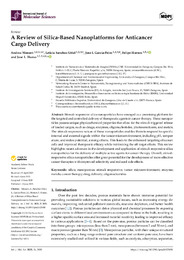Título :
A Review of Silica-Based Nanoplatforms for Anticancer
Cargo Delivery |
Autor :
Mosseri, Andrea
Sanchez-Uriel, Leticia
Garcia-Peiro, Jose I.
Hornos, Felipe |
Editor :
MDPI |
Departamento:
Departamentos de la UMH::Agroquímica y Medio Ambiente |
Fecha de publicación:
2025 |
URI :
https://hdl.handle.net/11000/36794 |
Resumen :
Stimuli-responsive silica nanoparticles have emerged as a promising platform for
the targeted and controlled delivery of therapeutic agents in cancer therapy. These nanoparticles
possess unique physicochemical properties that allow for the stimuli-triggered release
of loaded cargos, such as drugs, enzymes, oligonucleotides, photosensitizers, and metals.
The stimuli-responsive nature of these nanoparticles enables them to respond to specific
internal and external signals within the tumor microenvironment, including pH, temperature,
and redox potential, among others. This leads to the enhanced targeting of cancer
cells and improved therapeutic efficacy while minimizing the off-target effects. This review
highlights recent advances in the development and application of stimuli-responsive silica
nanoparticles for the delivery of multiple active agents for cancer therapy. Overall, stimuliresponsive
silica nanoparticles offer great potential for the development of more effective
cancer therapies with improved selectivity and reduced side effects.
|
Palabras clave/Materias:
silica
mesoporous
stimuli responsive
tumor microenvironment
enzyme
metals
cancer therapy
drug delivery
oligonucleotides |
Área de conocimiento :
CDU: Ciencias puras y naturales: Química |
Tipo de documento :
info:eu-repo/semantics/article |
Derechos de acceso:
info:eu-repo/semantics/openAccess
Attribution-NonCommercial-NoDerivatives 4.0 Internacional |
DOI :
https://doi.org/10.3390/ijms26125850 |
Publicado en:
International Journal of Molecular Sciences 2025, 26, 5850 |
Aparece en las colecciones:
Artículos Agroquímica y Medio Ambiente
|
 La licencia se describe como: Atribución-NonComercial-NoDerivada 4.0 Internacional.
La licencia se describe como: Atribución-NonComercial-NoDerivada 4.0 Internacional.
.png)
